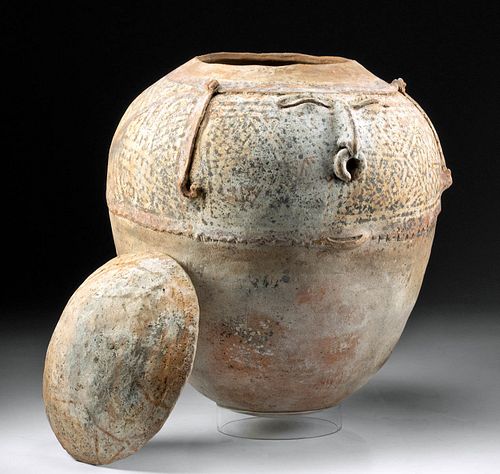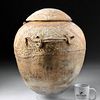Huge Colombian Tolima Polychrome Lidded Burial Urn
Lot 227
About Seller
Artemis Fine Arts
686 S Taylor Ave, Ste 106
Louisville, CO 80027
United States
Selling antiquities, ancient and ethnographic art online since 1993, Artemis Gallery specializes in Classical Antiquities (Egyptian, Greek, Roman, Near Eastern), Asian, Pre-Columbian, African / Tribal / Oceanographic art. Our extensive inventory includes pottery, stone, metal, wood, glass and textil...Read more
Categories
Estimate:
$5,000 - $7,500
Absentee vs Live bid
Two ways to bid:
- Leave a max absentee bid and the platform will bid on your behalf up to your maximum bid during the live auction.
- Bid live during the auction and your bids will be submitted real-time to the auctioneer.
Bid Increments
| Price | Bid Increment |
|---|---|
| $0 | $25 |
| $300 | $50 |
| $1,000 | $100 |
| $2,000 | $250 |
| $5,000 | $500 |
| $10,000 | $1,000 |
| $20,000 | $2,500 |
| $50,000 | $5,000 |
| $100,000 | $10,000 |
| $200,000 | $20,000 |
About Auction
By Artemis Fine Arts
Oct 7, 2021
Set Reminder
2021-10-07 10:00:00
2021-10-07 10:00:00
America/New_York
Bidsquare
Bidsquare : Exceptional Antiquities Ethnographic Fine Art
https://www.bidsquare.com/auctions/artemis-gallery/exceptional-antiquities-ethnographic-fine-art-7537
Museum-worthy examples of Egyptian, Greek, Roman, Etruscan, Near Eastern, Far East / Asian, Pre-Columbian, African / Tribal, Oceanic, Native American, Spanish Colonial, Fossils, Ancient Jewelry, Fine / Visual Arts, so much more! Artemis Fine Arts info@artemisgallery.com
Museum-worthy examples of Egyptian, Greek, Roman, Etruscan, Near Eastern, Far East / Asian, Pre-Columbian, African / Tribal, Oceanic, Native American, Spanish Colonial, Fossils, Ancient Jewelry, Fine / Visual Arts, so much more! Artemis Fine Arts info@artemisgallery.com
- Lot Description
Pre-Columbian, Colombia, Magdalena River Basin, Tolima, ca. 800 to 1500 CE. Painstakingly hand-built via the coiling technique, a colossal human effigy ceramic burial urn created to hold skeletal remains of a cherished ancestor. Ovoid in form, the redware vessel exhibits a narrow base and a wide shoulder, all topped by a convex lid. Its exterior walls are adorned with a thick band of a maze-like design comprised of many meandering striations, painted in red, black, and white pigments. One side of the vessel features a fascinating visage with squinting, coffee-bean eyes, a naturalistic nose donning a thick nose ring, and a petite slightly open mouth held in a gentle smile. Slender applied strips of clay surround the top and sides of the face, while a lizard-form handle can be seen on the opposite side. Size: 17.5" in diameter x 18.75" H (44.4 cm x 47.6 cm); 20" H (50.8 cm) on included custom stand.
In the valley of the River Magdalena, ancient rituals related to the preparation of the body of the deceased for its journey to the afterlife involved the practice of secondary burials in urns like this example. According to the curatorial department of the Museo del Oro Banco de la Republica, "There are two different stages in the secondary burial funerary custom: first of all, a primary burial takes place, where the corpse is buried for a certain period of time established in the ritual, and then after this, it is exhumed for burial once more in an urn, possibly amidst a great collective ceremony. Urns have been found in well tombs with side chamber, with certain local and regional variations. The chambers contain between three and seventy urns, each holding charred bone remains, large, fractured bones, and fragments of skull. Each is accompanied by pots, bowls, and goblets, most of which were made exclusively for the dead person, for they show no signs of having been used. Spindle whorls, rollers and axes have also been found." Examples from the Tolima culture are exceedingly rare.
This piece has been searched against the Art Loss Register database and has been cleared. The Art Loss Register maintains the world’s largest database of stolen art, collectibles, and antiques.
Provenance: private J. Hart Collection, Houston, Texas, USA, acquired in 1997; ex-Miguel Meja collection, Miami, Florida, USA, acquired pre-1970s
All items legal to buy/sell under U.S. Statute covering cultural patrimony Code 2600, CHAPTER 14, and are guaranteed to be as described or your money back.
A Certificate of Authenticity will accompany all winning bids.
PLEASE NOTE: Due to recent increases of shipments being seized by Australian & German customs (even for items with pre-UNESCO provenance), we will no longer ship most antiquities and ancient Chinese art to Australia & Germany. For categories of items that are acceptable to ship to Australia or Germany, please contact us directly or work with your local customs brokerage firm.
Display stands not described as included/custom in the item description are for photography purposes only and will not be included with the item upon shipping.
#167548Expected nicks, scratches, and abrasions, all commensurate with age. Otherwise, intact and excellent with nice remaining pigments and light earthen deposits throughout.Condition
- Shipping Info
-
All shipping is handled in-house for your convenience. Your invoice from Artemis Gallery will include shipping calculation instructions. If in doubt, please inquire BEFORE bidding for estimated shipping costs for individual items.
-
- Buyer's Premium



 EUR
EUR CAD
CAD AUD
AUD GBP
GBP MXN
MXN HKD
HKD CNY
CNY MYR
MYR SEK
SEK SGD
SGD CHF
CHF THB
THB















